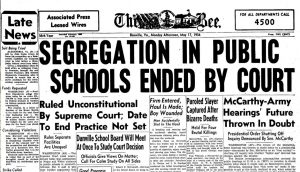Life of Black People in the US 1950: Brooklyn
Life of Black People in the US 1950: Brooklyn
In the US, in the 1950’s, post WWII, their was a large amount of discrimination and segregation against the blacks. A large group, was beginning to grow in the US, African-Americans, and even though they were fighting for equality for centuries, at this point, racism and segregation against black people has become a mainstream in the American life. Black people were put as a completely different class to the “powerful whites”. They were forced to always give their seats on the bus, which lead to the large protests, led by Rosa Parks, as well as, going to different schools, as all the white families, have pulled their children out of public schools in which black families had their children in and placed them in all white schools.
In addition, a large majority, were unable to get jobs in this time, and many of the blacks were servants to the whites. Almost 60% of African-American women, were servants for the whites. As you would expect this created protest, non-violent. However they worked, and in the next years, there were many rulings by the Supreme Court that favoured, blacks bringing equality back to them. In 1951, the Supreme Court ruled, unconstitutional to segregation against blacks in restaurants, the same for schooling in 1954, and transportation in 1956. This all finally led to the equality for blacks in the US. Furthermore, in this time, there were many immigrates migrating into the US, and there was indeed discrimination against them as well, not to the extent that the blacks faced but it was still a struggle. Many books were written to emphasise the struggle and explain to people how people had trouble in the US, due to race or nationality. One being “Brooklyn” written by Colm Tóibín.
Tóibín narrates the experience of an immigrant from Ireland coming into Brooklyn trying to settle in, in her “new home”. She is faced with many struggles , however she has already received the opportunity of a job and of a home, through Father Flood. This was an extremely privileged opportunity for her, especially in this time as there is a lot of racism going on in the US against immigrants. Since, Ellis is white, during the 1950’s in the US it was easier for her to settle in, get a job and a place to stay. Blacks at this time, as mentioned before were discriminated against, which made it extremely hard for them unlike Ellis to settle in and sustain a stable and standard living.

 1954, Brown v Board of Education: ended segregation in public schools. This was a huge win for the civil rights movements and is viewed today as one of the most important cases, and as the spark for the civil rights movement to really take off.
1954, Brown v Board of Education: ended segregation in public schools. This was a huge win for the civil rights movements and is viewed today as one of the most important cases, and as the spark for the civil rights movement to really take off.